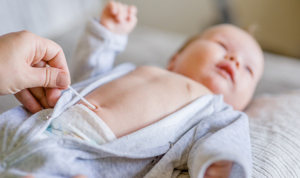|
Getting your Trinity Audio player ready...
|
Bringing a newborn into the world is a moment of pure joy and wonder. As you embark on this incredible journey of parenthood, one of the initial tasks is to care for your baby’s umbilical cord stump. While it may seem like a small detail, proper care is essential to ensure a smooth and infection-free healing process. In this comprehensive guide, we’ll walk you through the steps of caring for your newborn’s umbilical cord stump, from the first moments after birth to the time it naturally falls off.

Understanding the Umbilical Cord Stump
Before diving into the care process, it’s important to understand what the umbilical cord stump is and why it requires attention. The umbilical cord is the lifeline that connects your baby to the placenta in the womb, providing essential nutrients and oxygen. Following the birth of your baby, the umbilical cord is carefully clamped and then cut, leaving a small stump behind.This stump consists of tissue that will gradually dry out and fall off, revealing your baby’s belly button.
Initiating Care in the Hospital
Right after birth, healthcare providers will guide you on the initial steps to care for the umbilical cord stump. They’ll likely clean the stump and surrounding area with an antiseptic solution and instruct you on how to continue this process at home. It’s crucial to follow their guidance closely to prevent infection and promote healing.
Proper Cleaning Techniques
Maintaining cleanliness around the umbilical cord stump is crucial. For the first week or two, you’ll need to clean the stump and the area around it once or twice a day. Gently use a cotton ball or swab dipped in warm water to clean the base of the stump. Remember to pat it dry with a clean, soft cloth afterwards. Avoid using alcohol, hydrogen peroxide, or any other harsh substances, as they can delay the healing process.
Keeping it Dry
Excess moisture can hinder the healing process and increase the risk of infection. To keep the umbilical cord stump dry, it’s best to fold down the top of your baby’s diaper to expose the stump to air. Choose loose-fitting clothing that won’t rub against the stump and impede its healing.
Signs of Infection
While umbilical cord stump infections are rare, it’s important to be vigilant and aware of potential signs. If you notice any of the following symptoms, contact your healthcare provider promptly:
- Redness or swelling around the base of the stump
- Oozing pus or discharge
- Foul odour
- Increased fussiness or irritability in your baby
Dressing the Stump
As the umbilical cord stump heals, you’ll need to ensure it’s not hindered by clothing. Opt for clothing that has a special cutout or a fold-down front to keep the stump exposed. This promotes air circulation and prevents friction, allowing the stump to dry out and fall off naturally.
Navigating Bathtime
Bathing your newborn can be both a bonding experience and a concern for new parents. While the stump is still attached, you can give your baby sponge baths, avoiding direct contact with the stump. After the stump falls off, you can begin giving your baby gentle baths in a baby tub or sink. Always ensure that the umbilical cord area is thoroughly dried after bathing.
The Natural Falling-Off Process
As your baby grows, the umbilical cord stump will naturally start to detach. This typically happens around two to three weeks after birth, but it can vary. The stump will first become darker in colour and may even turn black before eventually drying up and falling off. Don’t be alarmed if you see a few drops of blood when the stump falls off; this is normal and indicates that the healing process is almost complete.
Celebrating the Healing Process
Finally, the day will come when the umbilical cord stump falls off, leaving behind your baby’s beautiful belly button. This moment marks the completion of the healing process and is a sign that your baby is growing and developing. Celebrate this milestone by taking a photo and cherishing the memory.
Conclusion
Caring for your newborn’s umbilical cord stump is a testament to the love and care you provide as a parent. By following these guidelines, you’re ensuring your baby’s health and setting the foundation for a healthy start in life.

